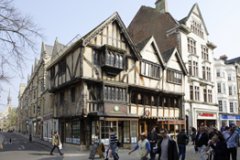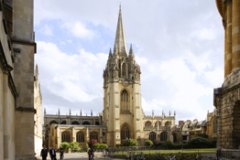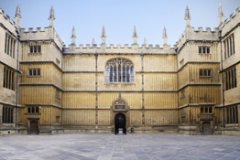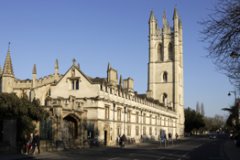Architecture Oxford
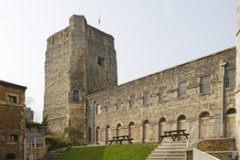 Oxford has a compact city centre with an outstanding collection of world famous buildings. Its origins lie in the late Saxon period and its original street pattern still survives along with some of its earliest monuments. It contains one of the best preserved groups of medieval and later university buildings in the world and a wealth of architectural gems from the classical to the modern.
Oxford has a compact city centre with an outstanding collection of world famous buildings. Its origins lie in the late Saxon period and its original street pattern still survives along with some of its earliest monuments. It contains one of the best preserved groups of medieval and later university buildings in the world and a wealth of architectural gems from the classical to the modern.
Below you will find some of Oxford's greatest buildings. Many of them owe their existence to the growth of the University of Oxford over 800 years, but not all. You will also find fine examples of the city's churches, houses and civic buildings - just a few of Oxford's special listed buildings of national and international importance.
Designed to guide the visitor through the city's most attractive and historic streets, the map towards the bottom of the page is an introduction to Oxford's architecture and a celebration of the development of the city over a thousand years.
The majority of the buildings featured here can be visited. There may be a small charge to visit some of these buildings at certain times. The postcodes listed are those of the main institution to which the featured building belongs. A GPS system may not direct you to the building listed here.
For further information and leaflets about guided walks and tours of Oxford please visit the Oxford Tourist Information Centre, 15-16 Broad Street, Oxford, OX1 3AS or the Experience Oxfordshire website.
1. St George's Tower C11th
A rare example of early stone military architecture. Standing four-storeys high with thick local ragstone walls, it defended the west gate of the Saxon town and later became the tower of St George's Chapel, the crypt of which survives. (See also the tower of the church of St Michael-at-the Northgate (C11th) which guarded the north gate.) In 1071, Robert D'Oilly incorporated it into his Norman Castle a tower on an earth mound, the latter still visible today.
Oxford Castle Unlocked, New Road, OX1 1AY
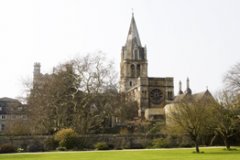 2. Christ Church Cathedral C12th and later
2. Christ Church Cathedral C12th and later
The site of the nunnery where Oxford first began it was refounded as the priory of St Frideswide in 1122 dedicated to Oxford's Patron saint, its mainly late Norman design survives. The first of Oxford's 'dreaming spires' and one of England's earliest was added c1325. The choir has a magnificent late C15th vault. It is the smallest cathedral in England and the chapel of Oxford's largest College, Christ Church where Christopher Wren's Tom Tower is a key motif in the city's skyline.
St Aldate's, OX1 1DP
3. New College C14th
Founded in 1379 by William of Wykeham, Bishop of Winchester, New College is one of the most significant Medieval buildings of its kind in Europe and an excellent example of English Perpendicular Gothic style. It was one of the first colleges to lay out its key buildings of Chapel, Hall, Library and sleeping rooms around a quadrangle which became the model for all later colleges. The College and gardens are enclosed by the well preserved C13th town walls.
New College Lane (also Holywell Street), OX1 3BN
4. Cornmarket Street4. 24-26 Cornmarket Street c1386-96
Built for a local wine merchant who called it the New Inn. This handsomely decorated building is a rare surviving example of a three-storey timber-framed dwelling with shops below (contemporary with New College above). It is a typical example of the houses of wealthier citizens in Oxford and northern Europe in general in this period.
Corner of Ship Street, OX1 3EY
5. Church of St Mary the Virgin C14th/15th
 The church and tower are key features of one of Europe's most beautiful streets. The C14th Gothic spire is magnificently decorated. A very fine baroque porch was added in 1637. It is both the parish and university church with long links to the University. The Old Congregation House, (now café) is the University's oldest building its first administrative centre (1320) with its library above. The tower provides classic views across the heart of the historic University city.
The church and tower are key features of one of Europe's most beautiful streets. The C14th Gothic spire is magnificently decorated. A very fine baroque porch was added in 1637. It is both the parish and university church with long links to the University. The Old Congregation House, (now café) is the University's oldest building its first administrative centre (1320) with its library above. The tower provides classic views across the heart of the historic University city.
High Street, OX1 4BJ
6. Divinity School 1427-1488 (& 1610-20)
Duke Humphrey's Library was created above a lecture room intended for Theology in order to house the books from St Mary the Virgin (see above). The vaults in the Divinity School are one of the great achievements of European Medieval architecture. The lierne vaults create a star-shaped pattern of an extraordinary delicacy and richness as they connect to 455 carved stone plaques to those who created it and gave money.
Old School's Quadrangle, Catte Street, (Bodleian Library), OX1 3BG
7. Magdalen College C15th
Founded in 1458 by William Waynflete, this College has one of the finest groups of late C15th buildings in the country set within extensive grounds behind high battlemented walls. The beautifully proportioned bell tower is one of Oxford's iconic images welcoming visitors to the city from the east and the focus for the city's traditional May Day celebrations.
High Street, OX1 4AU
8. Sheldonian Theatre 1664-7
Modelled on a U-shaped open air theatre in ancient Rome, this is Oxford's first Classical building and the first large building by Christopher Wren. The eight-sided cupola, (small dome on top), with its large windows offers fine views across the city. Within, are fine painted ceilings which screen the supporting structure of the 70-foot roof span. Next door, The Museum of Science, originally the Ashmolean Museum (1679-1683), was Britain's first public museum with a fine porch facing the theatre.
Broad Street, OX1 3AZ
9. Radcliffe Camera 1737-48
Built at a cost of £40, 000 donated by the charitable trust of John Radcliffe, a wealthy physician to William III. It was the first round library in the country. The rotunda was originally the idea of the architect Nicholas Hawksmoor but the work was interpreted by James Gibbs. It has one of the finest Classical interiors in England with the plasterwork in the upper room particularly excellent.
Radcliffe Square (Bodleian Library), OX1 3BG
10. Holywell Music Room 1748
This building designed by Thomas Complin and resembling a non-conformist chapel has a place in architectural history as the oldest purpose-built public music room in Europe and England's first concert hall. Many famous composers including Handel and Haydn have performed here. Holywell Street, one of the city's most picturesque streets, remains much as it would have looked in the late C17th.
Holywell Street, OX1 3SA
11. Radcliffe Observatory 1776-79
Built for the University with funds from the John Radcliffe trustees, the observatory is a major monument of Classical design inspired by the 1st century Tower of the Winds in Athens. Until 1936 telescopes surveyed the stars through the large windows. Of note are the frieze of the Winds carved in relief along the top and the panels of the Zodiac on the first floor. It is considered to be architecturally Europe's finest observatory.
